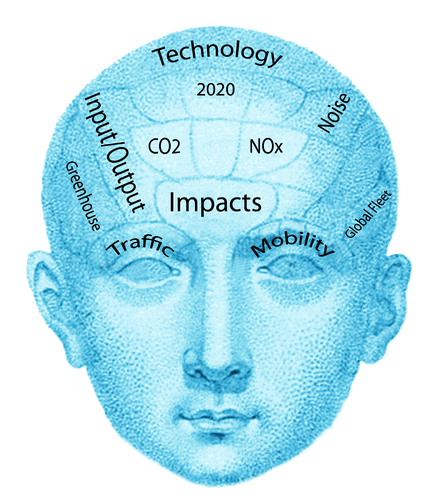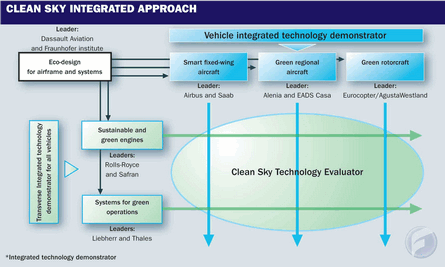Much of the work of Clean Sky, one of the European Union's largest-ever research efforts, is under way. But how will the findings of the six key areas where work is being focused converge to provide a framework for greener air transport?
With a budget of €1.6 billion ($2.3 billion), to be funded equally between the European Commission and industry from 2008-15, Clean Sky's main aim is to develop advanced technologies for the generation of aircraft entering service after 2015, speed up technological breakthrough developments and shorten the time to market for new "green" solutions.
Each research area contained within one of its six Integrated Technology Demonstrators (ITD) will select technologies for development from this year and mature them over two to three years before full-scale demonstrators are established in 2013-14.
 |
|---|
© James Mason/Flight International |
All will come together in the Clean Sky Technology Evaluator, responsible for assessing the environmental impact of those technologies. While standalone technologies will initially be evaluated at ITD design level, the Technology Evaluator will have the task of inserting new "conceptual aircraft", including a complete set of these new technologies, into various scenarios, using traffic growth and route forecasts from 2020.
FUTURE VISION
Only then will any attempt be made to form a vision of a range of aircraft likely to operate within those scenarios, achieving optimum fleet-wide environmental impact, and compare with a reference situation where these new technologies would not be introduced.
"For this purpose, air traffic is considered as a process with inputs, outputs and impacts, characterised through inventories and relevant metrics such as exposure of population to noise, air traffic contribution to local air quality around airports and global carbon dioxide production," says Olivier Hiernaux, a senior system of systems expert within Thales's aerospace business, which is leading the €31 million project together with the German aerospace centre DLR.
Environmental impact will be addressed holistically at several levels, such as during an aircraft's lifecycle phases, through to manufacturing, maintenance and withdrawal from service. It will also embrace single aircraft operation at mission level, at airport level, and take account of global air traffic operations at regional and global level.
Thales also has a presence in the Systems for Green Operations ITD, one of Clean Sky's six research areas. Sébastien Dubois, the programme manager appointed by Thales within Clean Sky, is co-leader with Liebherr of this ITD. Thales will build on a systems-oriented approach that it pioneered within its own 2006 Airlab initiative to develop technical and operational simulation environments for civil air transport.
Airlab provides a collaborative environment in which the key players in the air transport sector between ground and air can interact effectively from departure to arrival gate, taking into account flight management, airport navigation and environment monitoring as well as air traffic control, control tower and ground operations and airline operations.
Dubois says that Thales's unique industry presence within the Advisory Council for Aeronautic Research in Europe (ACARE) - its co-chairman is François Quentin of Thales Aerospace - in addition to its work on Galileo and the Single European Sky air traffic management research (SESAR) programme gives it a peerless perspective on research's unique relationship to societal systems.
"In this way we can leverage an essentially global approach where all our studies can be shared in an integrated way," says Dubois. "Why do we need a Technology Evaluator? Because we have to meet some pretty high-level targets, principally targets set down under ACARE - and sometimes it is really not so obvious to see the linkages between improving an engine or say an airframe and achieving those high-level targets."
 |
|---|
He adds: "The Technology Evaluator occupies a central position and with a budget of $31 million - or 2% of the overall Clean Sky budget of €1.6 billion. It is the first time such a lot of money has been devoted to a European-funded environmental impact assessment project."
Unlike the six ITDs, however, the Technology Evaluator will be organised differently in that its steering committee will be directly chaired by the director of the Clean Sky Joint Undertaking (JU) - a dedicated body recognised as having legal entity status whose responsibility is to monitor and control the whole Clean Sky for the duration of the project. The Technology Evaluator is due to start its activities in early November. While the emphasis is on consensus, Dubois admits it has to provide early results.
The Technology Evaluator will be a twofold organisation. Under the JU director's lead, it will have a strategic management responsibility that will determine its way of operating for assessing technology breakthrough achieved within each ITD and compare with environmental objectives in the Clean Sky timeframe. Secondly, it will have project management responsibilities (led by Thales and DLR) to keep its own €31 million budget on course.
The Technology Evaluator will be made up of 17 members - all 12 ITD leaders, plus representatives of the research community, including the four principal European research centres of France's ONERA, Germany's DLR, Italy's CIRA, the Netherlands' NLR and the UK's University of Cranfield.
Hiernaux says that in terms of workload, the research community will get the lion's share at two-thirds, which will help guarantee independent assessment. "We thought it extremely important that there was a correct linkage between industry and the research community and thought this was the best way to ensure a high level of interaction," he says.
DEMONSTRATOR RESULTS
While each ITD has to offer a quarter of its research area in the form of calls for partners, the Technology Evaluator does not, simply focusing on the demonstrator results. So it will not drill down to the level of technology research as in the Smart Fixed Wing Aircraft ITD, for example.
"It has to take into account a global system approach. That could mean evaluating up to several hundreds of technologies. That requires a special process and could mean deciding on trade-offs, as some technologies may prove to have a more significant impact than others," says Hiernaux, who adds that first results should be feeding through in two years.
"The Technology Evaluator has to deliver that assessment and will share the data to a wide audience to help the internal operations of Clean Sky and to disseminate the direction of the technologies in terms of their capacity to reduce the environmental impact."
The duties of the Technology Evaluator therefore will be primarily monitoring for the benefit of JU stakeholders, something Hiernaux says will be "its most visible objective". It will also bring in some consistency in terms of technological methodology - noise measurement parameters, for example, between aircraft and helicopters within their respective ITDs could be materially different. Finally, it will apply a broader perspective and through that secure a synergy by identifying vital interdependencies.
What if some technologies are really not worth pursuing? "This is where the synergy effect comes into play," says Hiernaux. "We will use the Technology Evaluator as a kind of tool providing a comprehensive analysis of solutions implemented at system level and, through that, we will be able to bring a global dimension that would not be normally available within one ITD alone."
MEETING EUROPE'S GREEN GOALS
Clean Sky's purpose is to demonstrate and validate the technology allowing the European industry to meet, by 2020, environmental goals sets by the Advisory Council for Aeronautics Research in Europe, the European technology platform for aeronautics and air transport. Its Strategic Research Agenda has served as a major source of input in the formulation of the aeronautics work programme of the European Union's Seventh Research Framework Programme, which includes:
- 50% cut in carbon dioxide emissions through reduced fuel consumption.
- 80% reduction of nitrous oxides emissions.
- 50% reduction of external perceived noise.
- Green product lifecycle: design, manufacturing, maintenance, disposal.
Source: Flight International



















